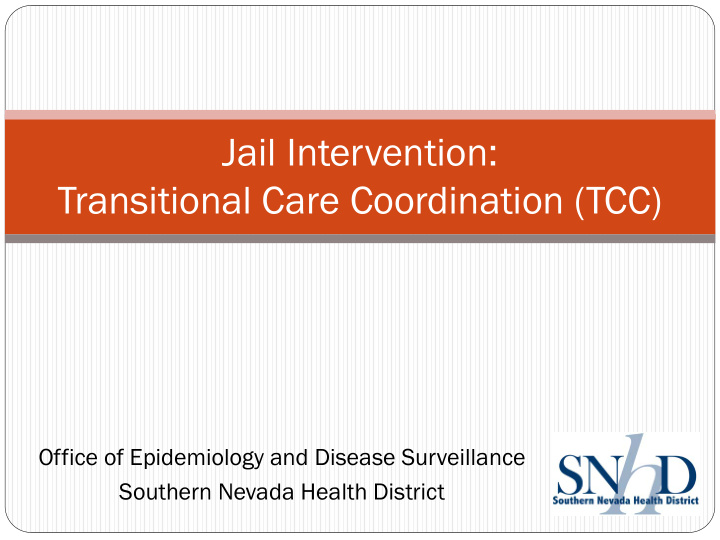



Jail Intervention: Transitional Care Coordination (TCC) Office of Epidemiology and Disease Surveillance Southern Nevada Health District
For Today Background Transitional Care Coordination (TCC) Model Preliminary Findings Challenges Expected Community Impacts
Background 3 year grant to implement TCC intervention Grant Sponsors: AIDS United and Boston University Grantee Sites: SNHD, Clark County, NV UNC at Chapel Hill, NC Cooper Health System, Camden, NJ
The SNHD Team Core Team Joey Arias – Clinical Social Worker Supervisor Kathryn Barker – Principal Investigator Jason Butts – Data Manager/Project Manager Kelli O’Connor – Care Coordinator Leonard Taylor – Care Coordinator Support Team Elizabeth Adelman – Sr. DIIS Victoria Burris – Communicable Disease Supervisor Linus Mubuifor – Community Health Nurse Lourdes Yapjoco – Community Health Nurse Supervisor
Lifetime Risk of HIV Diagnosis, by State Source: CDC. Lifetime risk of HIV diagnosis [press release]. February 23, 2016.
Why Jails? Most incarcerated people with HIV got the virus before entering a correctional facility 2 HIV testing at a correctional facility may be the first time incarcerated people are tested and diagnosed with HIV 2 Among jail populations, African American men are 5 times as likely as white men, and twice as likely as Hispanic/Latino men, to be diagnosed with HIV 2 Among jail populations, African American women are more than twice as likely to be diagnosed with HIV as white or Hispanic/Latino women 2 Over 70% of people released to the community after incarceration return to the areas of greatest socioeconomic and health disparities 1 1. Jordan AO, Cohen LR, Harriman G, Teixeira, PA, Cruzado-Quinones J, Venters H, Transitional Care Coordination in New York City Jails: Facilitating Linkages to Care for People with HIV Returning Home from Rikers Island, AIDS Behav Oct 2013. 2. Centers for Disease Control and Prevention. HIV Among Incarcerated Populations. https://www.cdc.gov/hiv/group/correctional.html
Transitional Care Coordination TCC is an evidenced-based intervention developed at Rikers Island, NY Central Aim of TCC Facilitate the linkage of a client living with HIV to community-based HIV primary care and treatment services after incarceration, beginning while the individual is in jail
Continuum of Care • Opt-in HIV testing
TCC in Action Identify Population • Individuals with HIV in jail Engage Client • Social work tenets, incentives • Needs for housing, transportation, health Conduct Assessment insurance/benefits, etc. Coordinate a • Referral to needed services, set appointments Post-Release Plan Ensure Continuity of • 7 days of medication plus prescription Medications at Discharge Facilitate • Follow-up, check-in once in community Continuity of Care
Clark County Detention Center At A A Glanc ance (2 (2015) Facilities CCDC, North Valley Complex Average Daily Pop 4,007 56,299 or 154/day Bookings Community Releases 56,643 Length of Stay mean=25 days Medical Services Naphcare, Inc. (contracted vendor)
Preliminary Findings (N=49) Char arac acteristic istics s N (%) Age Mean: 37 years Range: 21–57 years Gender Male 42 (88%) Female 4 (8%) Transgender/Other 3 (6%) Race 23 (47%) African-American/Black 27(55%) White 9 (18%) American Indian/Alaskan Native 3 (6%) Other/Multiracial/Refuse to Answer Ethnicity- Hispanic/Latino 7 (14%)
Preliminary Findings (N=49) Char arac acteristic istics s N (%) Residence prior to incarceration Own home/apartment (rent or own) 17 (35%) Someone else's home/apartment 17 (35%) Residential or transitional housing 1 (2%) Treatment program 1 (2%) Homeless- the streets/in a car/in a park 13 (27%)
Preliminary Findings (N=49) Char arac acteristic istics s N (%) Run out of money prior to incarceration 11 (22%) Never 15 (30%) Daily 10 (20%) Weekly 11 (22%) Monthly Number of times previously incarcerated Mean: 4 Range: 0 - 25
Preliminary Findings (N=49) Char arac acteristic istics s N (%) Insurance Medicaid 35 (71%) Medicare 1 (2%) Private 4 (8%) VA 2 (4%) None 9 (18%)
Preliminary Findings (N=49) Char arac acteristic istics s N (%) Unmet needs in past 6 mos. before incarceration Housing 26 (53%) Transportation 28 (57%) Medical Care 17 (35%) Mental Health/Substance Use 20 (41%) Substance use in past 12 months 40 (82%) Cigarettes 16 (33%) Alcohol (Binge drinking) 34 (69%) Marijuana 8 (16%) Cocaine/Crack 29 (59%) Amphetamines (including meth) 6 (12%) Opiates
Challenges Community Resources HOUSING Employment Opportunities Transportation Mental Health and Substance Abuse Treatment Recidivism Limited Staffing Resources
Outcomes and Impacts What to Expect in Indicator Outcomes at Other Sites Clark County Clinical Care CD 4 (mean) INCREASE INCREASE (416 to 439) vL (mean) DECREASE DECREASE (39,642 to 15,607) Undetectable vL INCREASE INCREASE (9.9% to 21.1% ) Engagement in Care # Taking ART INCREASE INCREASE (57% to 89%) ART Adherence INCREASE INCREASE (68% to 90%) Avg. # ED visits p/p DECREASE DECREASE (1.1 to .59) Survival Needs Homelessness DECREASE DECREASE (36.2% to 19.2%) Hunger DECREASE DECREASE (37.4% to 14.1%)
Contact Kathryn Barker, MPH Epidemiologist and Principal Investigator Office of Epidemiology and Disease Surveillance 702-759-1387 barker@snhdmail.org Southern Nevada Health District 280 S. Decatur Blvd.
Recommend
More recommend